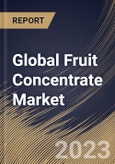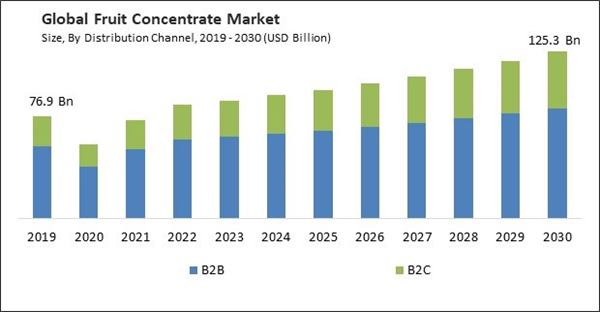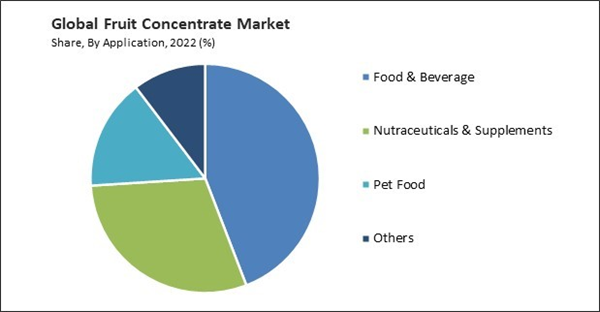The Global Fruit Concentrate Market size is expected to reach $125.3 billion by 2030, rising at a market growth of 5.1% CAGR during the forecast period. In the year 2022, the market attained a volume of 13,804.8 Kilo Tonnes experiencing a growth of 4.1% (2019-2022).
Fruit concentrates can be used in various food and beverage applications, from juices and smoothies to bakery goods, confectionery, and sauces. Therefore, Food & Beverage segment generated $37,578.5 million revenue in the market in 2022. As a result, their versatility allows manufacturers to incorporate them into diverse products, expanding the range of consumer offerings. Thus, there will be increased demand for food concentrates in the coming years. Some of the factors impacting the market are increasing growth in the food and beverages industry, rising demand for natural ingredients and rising health concerns related to fruit concentrate.
It offer a concentrated source of natural flavors, essential in the processed food industry. They allow manufacturers to maintain consistent and desirable flavor profiles in their products. This quality enhancement can contribute to consumer satisfaction and brand loyalty. They allow manufacturers to reduce the need for artificial sweeteners and flavor enhancers, which can be perceived as less healthy. By using these, manufacturers can tap into the trend of offering more natural and health-conscious products. Additionally, It can produce various health-focused products, such as fruit-flavored yogurts, smoothies, and functional beverages. Their association with health and wellness trends can open up opportunities in these growing market segments. Manufacturers and brands can use fruit concentrates' natural and healthy attributes as a marketing strategy. Promoting the use of real fruit concentrates in their products can build trust and consumer loyalty. Thus, these factors will drive the expansion of the food concentrate market and these factors will propel the future expansion of the food concentrate market.
However, manufacturers may need to reformulate their products to reduce sugar content or seek alternative sweeteners to address consumer concerns. This may lead to a shift away from fruit concentrates in favor of other ingredients. Companies using it may face marketing challenges, as they need to address consumer concerns about sugar content and communicate the benefits of using concentrates in a way that resonates with health-conscious consumers. Concerns about high sugar content can lead to regulatory pressure and potential changes in labeling and nutritional requirements. These changes may impact the market's ability to market and sell products containing fruit concentrates.
The market research report covers the analysis of key stake holders of the market. Key companies profiled in the report include Ingredion Incorporated, Dohler GmbH, Archer Daniels Midland Company, AGRANA Beteiligungs-AG, Lemonconcentrate S.L.U, SunOpta, Inc., Kerry Group plc, Coöperatie Koninklijke Cosun U.A., Capricorn Food Product India Ltd. and The Coca Cola Company.
Fruit concentrates can be used in various food and beverage applications, from juices and smoothies to bakery goods, confectionery, and sauces. Therefore, Food & Beverage segment generated $37,578.5 million revenue in the market in 2022. As a result, their versatility allows manufacturers to incorporate them into diverse products, expanding the range of consumer offerings. Thus, there will be increased demand for food concentrates in the coming years. Some of the factors impacting the market are increasing growth in the food and beverages industry, rising demand for natural ingredients and rising health concerns related to fruit concentrate.
It offer a concentrated source of natural flavors, essential in the processed food industry. They allow manufacturers to maintain consistent and desirable flavor profiles in their products. This quality enhancement can contribute to consumer satisfaction and brand loyalty. They allow manufacturers to reduce the need for artificial sweeteners and flavor enhancers, which can be perceived as less healthy. By using these, manufacturers can tap into the trend of offering more natural and health-conscious products. Additionally, It can produce various health-focused products, such as fruit-flavored yogurts, smoothies, and functional beverages. Their association with health and wellness trends can open up opportunities in these growing market segments. Manufacturers and brands can use fruit concentrates' natural and healthy attributes as a marketing strategy. Promoting the use of real fruit concentrates in their products can build trust and consumer loyalty. Thus, these factors will drive the expansion of the food concentrate market and these factors will propel the future expansion of the food concentrate market.
However, manufacturers may need to reformulate their products to reduce sugar content or seek alternative sweeteners to address consumer concerns. This may lead to a shift away from fruit concentrates in favor of other ingredients. Companies using it may face marketing challenges, as they need to address consumer concerns about sugar content and communicate the benefits of using concentrates in a way that resonates with health-conscious consumers. Concerns about high sugar content can lead to regulatory pressure and potential changes in labeling and nutritional requirements. These changes may impact the market's ability to market and sell products containing fruit concentrates.
Distribution Channel Outlook
On the basis of the distribution channel, the market is bifurcated into B2B and B2C. The B2B segment recorded the maximum revenue share in the market in 2022. B2B customers, like food and beverage manufacturers, often require customized solutions. Fruit concentrate suppliers have adapted to this demand by offering various fruit varieties and blends, allowing businesses to create unique and innovative products. The market has expanded due to international trade and export opportunities. These are traded globally, with suppliers and manufacturers sourcing raw materials from various regions. This globalization has spurred growth in the B2B segment. Hence, the demand will increase in the B2B segment.B2C Outlook
The B2C segment is further segmented into online sales, hypermarkets/supermarkets, wholesale stores, and others. In 2022, the hypermarkets/supermarkets subsegment witnessed the largest revenue share in the market. Hypermarkets and supermarkets offer a one-stop shopping experience for consumers. Shoppers can purchase various products, including fruit concentrates and other groceries, in a single trip. This convenience attracts consumers who prefer grocery shopping in one place. Hypermarkets and supermarkets typically stock diverse products, including various brands and flavors of fruit concentrates. This variety allows consumers to choose from a broad selection, catering to different tastes and preferences. Thus, the segment will witness an increased demand in the upcoming years.Application Outlook
Based on application, the market is divided into food & beverage, nutraceuticals & supplements, pet food, and others. In 2022, the pet food segment garnered a significant revenue share in the market. Pet owners are displaying growing concern regarding their pets' health and overall welfare. Just as in human food, there is a growing interest in natural and healthy ingredients for pet food. Fruit concentrates, which contain essential nutrients, antioxidants, and natural flavors, can enhance pet food's nutritional value. Pet owners are looking for clean-label and natural pet food products. As natural ingredients, fruit concentrates could replace artificial flavors, colors, and preservatives in pet formulations.Food & Beverage Outlook
The food and beverages segment is further segmented into dairy based beverages, non-dairy beverages, confectionery, bakery, snacks, desserts & condiments, and others. In 2022, the bakery subsegment garnered a promising revenue share in the market. Many consumers are looking for clean-label products with minimal additives and preservatives. These are often perceived as a clean and natural ingredient, making them popular for bakers looking to meet these consumer preferences. It come in various flavors, allowing bakers to experiment and create unique and innovative baked goods. The versatility of fruit concentrates in terms of flavor profiles and applications in various baked products contributes to their growth in this subsegment.Source Outlook
By source, the market is segmented into apple, citrus fruits, pineapple, grapes, pear, berries, and others. In 2022, the berries segment garnered a promising significant revenue share in the market. Berries are often associated with health and wellness due to their high vitamin, antioxidant content, and other beneficial compounds. As consumer awareness of the health benefits of berries grows, demand for berry-based products, including concentrates, tends to increase. Many consumers are looking for natural and clean-label products. Berries are naturally rich in flavor and color, making them an attractive ingredient for manufacturers looking to create clean-label products. Fruit concentrates from berries are often seen as a natural alternative to artificial flavors and colors. Therefore, the demand in the segment is expected to grow in the coming years.Regional Outlook
By region, the market is segmented into North America, Europe, Asia Pacific, and LAMEA. In 2022, the Europe segment acquired a considerable revenue share in the market. Europe has historically been a significant market for fruit concentrates. The demand in Europe has steadily increased due to their various applications in the food and beverage industry, including juices, soft drinks, dairy products, and bakery items. The Europe segment has seen a diversification of fruit concentrates. Apart from the traditional orange and apple concentrates, there has been a rise in demand for exotic and tropical fruit concentrates. This diversification has contributed to market growth. Hence, the future demand will rise in the segment.The market research report covers the analysis of key stake holders of the market. Key companies profiled in the report include Ingredion Incorporated, Dohler GmbH, Archer Daniels Midland Company, AGRANA Beteiligungs-AG, Lemonconcentrate S.L.U, SunOpta, Inc., Kerry Group plc, Coöperatie Koninklijke Cosun U.A., Capricorn Food Product India Ltd. and The Coca Cola Company.
Scope of the Study
Market Segments Covered in the Report:
By Distribution Channel (Volume, Kilo Tonnes, USD Billion/Million, 2019-2030)- B2B
- B2C
- Hypermarkets/supermarkets
- Wholesale Stores
- Online sales
- Others
- Food & Beverage
- Non-Dairy Beverages
- Dairy based Beverages
- Confectionary
- Bakery
- Snacks
- Desserts & Condiments
- Others
- Nutraceuticals & Supplements
- Pet Food
- Others
- Apple
- Pineapple
- Pear
- Berries
- Citrus Fruits
- Grapes
- Others
- North America
- US
- Canada
- Mexico
- Rest of North America- Europe
- Germany
- UK
- France
- Russia
- Spain
- Italy
- Rest of Europe- Asia Pacific
- China
- Japan
- India
- South Korea
- Singapore
- Malaysia
- Rest of Asia Pacific- LAMEA
- Brazil
- Argentina
- UAE
- Saudi Arabia
- South Africa
- Nigeria
- Rest of LAMEA
Key Market Players
List of Companies Profiled in the Report:
- Ingredion Incorporated
- Dohler GmbH
- Archer Daniels Midland Company
- AGRANA Beteiligungs-AG
- Lemonconcentrate S.L.U
- SunOpta, Inc.
- Kerry Group plc
- Coöperatie Koninklijke Cosun U.A.
- Capricorn Food Product India Ltd.
- The Coca Cola Company
Unique Offerings
- Exhaustive coverage
- The highest number of Market tables and figures
- Subscription-based model available
- Guaranteed best price
- Assured post sales research support with 10% customization free
Table of Contents
Chapter 1. Market Scope & Methodology
Chapter 2. Market at a Glance
Chapter 3. Market Overview
Chapter 4. Global Fruit Concentrate Market by Distribution Channel
Chapter 5. Global Fruit Concentrate Market by Application
Chapter 6. Global Fruit Concentrate Market by Source
Chapter 7. Global Fruit Concentrate Market by Region
Chapter 8. Company Profiles
Companies Mentioned
- Ingredion Incorporated
- Dohler GmbH
- Archer Daniels Midland Company
- AGRANA Beteiligungs-AG
- Lemonconcentrate S.L.U
- SunOpta, Inc.
- Kerry Group plc
- Coöperatie Koninklijke Cosun U.A.
- Capricorn Food Product India Ltd.
- The Coca Cola Company
Methodology

LOADING...










